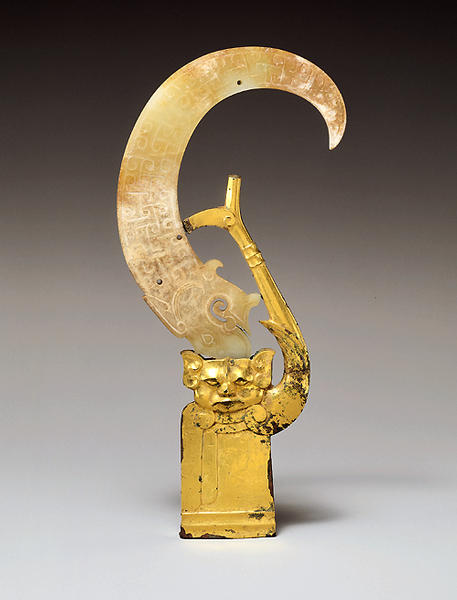怪神形金具
- 中国
- 中国・前漢時代(青銅鍍金像部分)
- 青銅鍍金像/前2-1、玉/前5-3世紀
- 青銅鍍金、金、玉
- H-16.2
超自然的存在の形象をもつ前漢時代の青銅鍍金製の把手と、東周時代初期の龍の形をなす玉の下げ飾りの二つの別の工芸品を組み合わせてできている。この像は蝋型鋳造され、半人半獣の姿をもつものと見なされる。内側に向けて巻き込む二つの渦巻きを末端とする輪郭の中にその窪みを表した動物の耳、幅広い鼻、丸々とした頬、ふっくらした唇、そして翼の重なった一本の腕。腕は先端で二股に分かれ、末端は破損している。この作品の玉製の下げ飾りは非常に重要なものと見なされていたに違いない。玉の表面の青銅の腐食作用によって生じた染みが暗に示すのは、玉と青銅鍍金の像が最近組み合わされたものではないということである。しかしながら両者の結合は漢代中国の美意識とは相容れないようである。龍の下げ飾りの鼻を後世に製作された金銅製の断片の細長い穴に下向きに挿入することは、こうした玉器が中国文化において有していた重要性に対しての、ある感受性を欠いている。古い玉器を時代の下る青銅鍍金及び金製の台に愛情をこめて嵌め込んだ例は大量にあり、その意味ではこれらは本作品の先行例であるといえる。しかしこうした作例においてはいずれも玉は多大な敬意の念をもって扱われている。この作品にみられる結合はおそらく異国人とみられる古代のある好事家の個人的な趣味を表しているに違いない。
Catalogue Entry
One of the most fascinating but enigmatic objects in the Shumei collection is this graceful figure formed by joining two separate artifacts together: a Western Han-period gilt-bronze handle in the shape of a supernatural figure and an earlier Eastern Zhou-period dragon-shaped jade pendant. The figure was lost-wax cast and was conceived as part human and part animal, with animal ears defined by a sunken area within an outline ending in two inward spirals, a broad nose, fat cheeks, full lips, and one arm with a superimposed wing. The arm is represented with a bifurcated end terminating in broken stumps, one of which almost touches the jade. It appears that originally this section would have split in two thin metal strips that most likely would have extended over and under the jade and over and under the two holes. This is indicated by two ungilded and corroded break surfaces in an otherwise gilded strip. If so, it would also explain the two holes in the jade and would have provided support for the break in the jade. The body of the figure is a rectangular shape with a deep slot in the bottom to fit some unidentified object, and a slit in the head, into which the snout of the jade dragon was inserted and secured by two rivets, both of which appear to be ancient. One rivet, closer to the center, is of a copper alloy and does not extend to the other side; the second rivet is made of gold and does extend all the way through. The figure and the copper alloy rivet were mercury amalgam gilded.1
The jade pendant must have been regarded as having great importance. Stains from bronze corrosion products on the jade indicate that the two pieces were not combined recently.2 However, their marriage seems contradictory to Han Chinese aesthetics. To insert a dragon pendant nose down into a slot in a later gilt-bronze fragment lacks a certain sensitivity to the significance of such jades in Chinese culture. Numerous examples of early jades lovingly set in later gilt-bronze and gold mounts provide precedents of sorts, but in each case the jade was treated with great respect.3 The combination here must represent the individual taste of some early connoisseur, perhaps a foreigner, but when and why it was made remain a mystery.
ECB
1. I very grateful to Dr. Pieter Meyers from the detailed technical description based on microscopic examination.
2. As was suggested in Metropolitan Museum 1996, p. 128.
3. Rawson et al. 1995, pp. 304-6, no. 22.1 and comparative pieces.
